Think succulents and cacti are just for the desert? Not true! They do great indoors too. They add cool textures, shapes, and colors to your home with little work. With over 150 Echeveria types, you can pick the perfect one for you.
Starting your Echeveria care journey is exciting. You’ll learn how to give them the right light, water, and food. By following our tips, you’ll make a beautiful indoor space with these amazing plants. They’re easy to care for and look great, making them a favorite for indoor gardeners.
This guide is for everyone, whether you’re new to gardening or not. It covers all you need to know about Echeveria care. You’ll learn how to make your Echeveria plants happy and healthy. Soon, you’ll be an Echeveria expert, enjoying all the good things they bring to your home.
Understanding Echeveria and Its Beauty
To truly appreciate Echeveria’s beauty, you must know its unique traits. These succulents have compact rosettes and plump leaves. They can be red or pink.
The Echeveria watering guide says to let the soil dry before watering. This prevents root rot and keeps the plant healthy.
Echeveria is known for its stunning bell-shaped flowers. With over 150 species, you can pick the perfect one for your garden. Popular varieties like Echeveria ‘Perle von Nürnberg’ and Echeveria ‘Black Prince’ are easy to care for.
The Unique Characteristics of Echeveria
Echeveria is special because of its striking look and small size. It stores water in its leaves and likes bright, indirect light. By following the watering guide and providing the right conditions, your Echeveria will thrive.
Popular Echeveria Varieties to Consider
Some popular Echeveria varieties include:
- Echeveria ‘Perle von Nürnberg’
- Echeveria ‘Black Prince’
- Echeveria ‘Lola’
- Echeveria ‘Imbricata’
By choosing the right variety and following the watering guide, you can enjoy Echeveria’s beauty. You’ll learn how to care for it easily.
Ideal Growing Conditions for Echeveria
To make your Echeveria happy, you need to know what it likes. These plants love bright, indirect light. A south or west window is great, but watch out for too much sun.
Also, the soil is very important. It should drain well to avoid root rot. A mix made for cacti and succulents is best.
The perfect temperature is between 65°F to 75°F (18°C to 24°C) during the day. At night, it should be around 55°F (13°C). Keeping the right temperature and humidity helps prevent problems.
- Echeveria sunlight requirements: 6 hours of bright light during Winter and 8 to 12 hours of light each day during Spring and Summer
- Echeveria soil requirements: a well-draining soil mix with a slightly acidic pH of around 6.0
- Temperature: between 65°F to 75°F (18°C to 24°C) during the day and around 55°F (13°C) at night
By following these tips, your Echeveria will do great. Just remember to water it carefully. Let the soil almost dry out before watering again.
Watering Techniques for Echeveria
To care for your Echeveria, learn the Echeveria watering guide and Echeveria care tips. Watering needs change with the seasons. In Spring to Summer, keep the soil a bit wet. In late Fall to Winter, water less often.
Check if the soil is dry by sticking your finger in it. If it’s dry up to the first knuckle, it’s time to water.
Here are some tips for watering your Echeveria:
- Water deeply but infrequently, allowing the soil to dry out completely between waterings to prevent root rot.
- Reduce watering frequency during the winter months when the plant is dormant.
- Use a moisture meter or manual soil check to prevent over-watering.
For more info on overwatering signs and saving indoor plants, check trusted sources. Remember, bad watering is the main reason for Echeveria problems. By following these Echeveria care tips and Echeveria watering guide, your plant will stay healthy and grow well.
| Season | Watering Frequency |
|---|---|
| Spring to Summer | Keep potting mix slightly moist |
| Late Fall to Winter | Water less sparingly |
Fertilizing Echeveria for Healthy Growth
To keep your Echeveria happy, it needs the right food. Fertilizing is key in Echeveria care. Feed your Echeveria every 4-6 weeks in spring and summer. This helps it grow strong and bloom beautifully.
Choose a balanced fertilizer with an N-P-K ratio of 2:1:1. This mix is good for your Echeveria. But, don’t forget to water it down to half strength. This keeps the roots safe.
Types of Fertilizers to Use
There are many fertilizers for your Echeveria. Here are a few:
- Balanced, water-soluble fertilizers
- Diluted liquid fertilizers
- Organic fertilizers, such as compost or manure tea
When and How Often to Fertilize
Apply fertilizer when your Echeveria is growing. That’s every 4-6 weeks in spring and summer. Always follow the package’s instructions and water down the fertilizer. This keeps your Echeveria healthy and happy.
Repotting Your Echeveria
As your Echeveria grows, it might outgrow its pot. This means it’s time to repot it. Repotting can seem scary, but it’s easy if you know how. Look for signs like the plant getting too heavy, the soil getting old, or roots showing outside.
When you repot, carefully take the plant out of its pot. Be gentle with the roots. Cut any dead roots before putting it in a new pot. Pick a pot that’s just a bit bigger than the old one. Use a mix that drains well to keep the soil right.
Here are some important tips for repotting your Echeveria:
- Use a pot that is 1-2 inches larger in diameter than the current pot
- Choose a well-draining potting mix to prevent waterlogged soil
- Trim any dead or rotting roots before repotting
- Water sparingly after repotting to prevent shocking the roots
By following these steps, your Echeveria will do great in its new home. Keep an eye on your plant and change its care as needed. This will help it keep growing and looking good.
| Repotting Frequency | Recommended Pot Size | Soil Mix |
|---|---|---|
| 1-2 times a year | 1-2 inches larger than current pot | Well-draining potting mix |
Echeveria Propagation
Exploring Echeveria care leads to fun ways to share plants or grow your collection. To succeed, follow key Echeveria propagation tips. You can use leaf cuttings or offsets, both needing careful steps.
For leaf cuttings, pick healthy leaves and let them dry a bit. This helps prevent rot and encourages roots. Offsets need gentle separation and their own pots. Keep the soil right until they grow strong, using Echeveria care tips.
Methods for Propagating Echeveria
- Leaf cuttings: Allow leaves to dry for a few days before planting
- Offsets: Separate from the mother plant and plant in well-draining soil
By using these Echeveria propagation tips and the right care, you’ll grow your Echeveria. Watch the soil moisture and water right, as wrong watering harms plants.
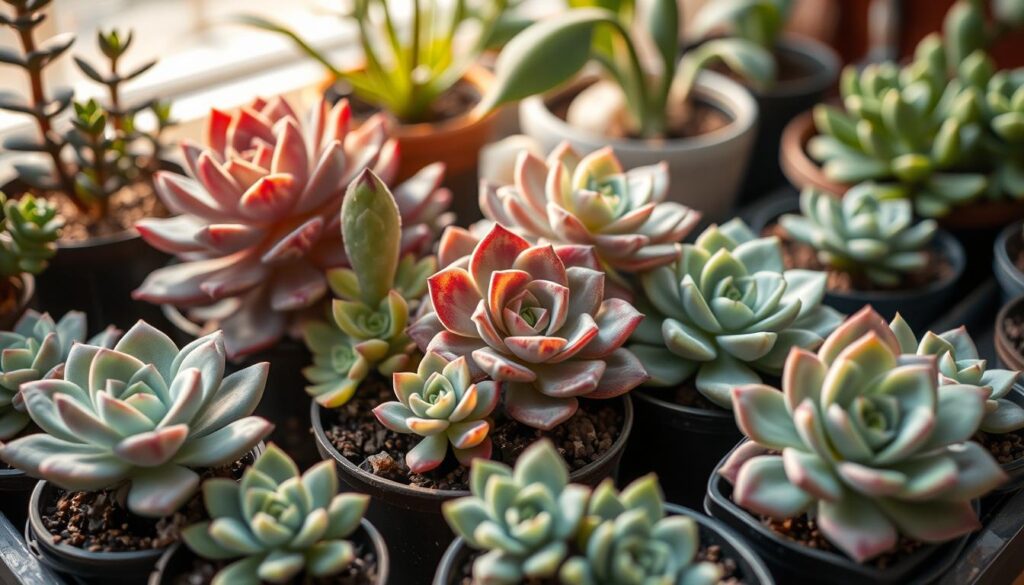
Tips for Successful Propagation
| Method | Success Rate | Time to Establish |
|---|---|---|
| Leaf Cuttings | High | 2-4 weeks |
| Offsets | High | 1-3 weeks |
With patience and practice, you’ll master Echeveria propagation. Enjoy these plants in your home or garden. Follow these tips to become an Echeveria expert.
Pest Management for Echeveria
When you take care of your Echeveria, watch out for pests. Look for white, cottony patches or fine webbing. Echeveria pest control is key to keep your plant healthy.
Common pests like mealybugs, spider mites, and scale can harm Echeveria. Use natural remedies like neem oil or insecticidal soap to get rid of them. For example, mealybugs can be treated with alcohol-soaked cotton swabs or insecticidal soap. Keeping your Echeveria well-watered and fertilized can also help prevent pests.
- Water your Echeveria sparingly, as overwatering can attract pests
- Fertilize your Echeveria regularly, but avoid overfertilizing
- Inspect your Echeveria regularly for signs of pests
Follow theseEcheveria maintenance tips and use natural pest control. This will help your Echeveria stay healthy and strong.
Pest management is an essential part of Echeveria care. By being proactive and taking steps to prevent pest infestations, you can help ensure the health and well-being of your plant.
Dealing with Echeveria Diseases
When you care for your Echeveria, watch out for diseases. Root rot is a big problem from too much water. Make sure your pot drains well and use a mix that doesn’t hold water. Learn more about Echeveria care tips to keep your plant safe.
Diseases like powdery mildew, leaf spots, and root rot can hit Echeveria. To avoid these, keep your plant well-ventilated, water smartly, and feed it when it’s growing. Here’s how to stop and fix these problems:
- Check your plant often for disease or pests
- Make sure air moves well to stop fungal diseases
- Water right, so you don’t drown your plant
- Feed it when it’s growing to help it stay strong
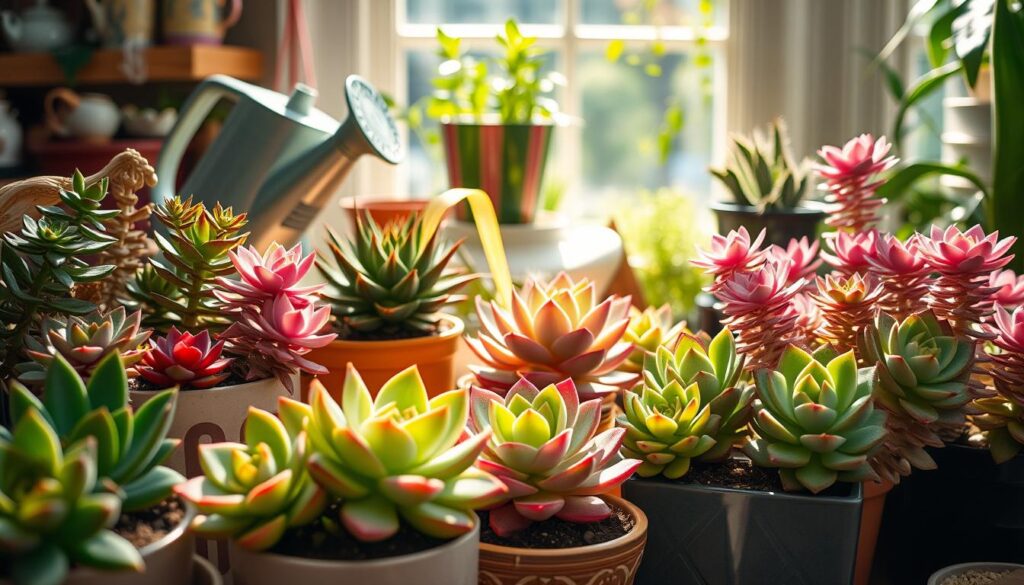
By following these steps and knowing about Echeveria care tips and Echeveria maintenance tips, you can stop diseases. This will keep your Echeveria happy and healthy.
Seasonal Care Tips for Echeveria
As you care for your Echeveria, changing your routine with the seasons is key. This helps your plant stay healthy all year. In winter, your Echeveria needs less water and food. So, you must adjust your Echeveria maintenance tips.
Here are some tips for each season:
- Water less in winter since the plant is sleeping and needs less water.
- Give it enough light, about 6 hours of bright light, because days are shorter.
- Keep your Echeveria safe from frost, as it can hurt the plant.
By following these Echeveria care tips, you’ll give your plant the best care. Remember, adjust your Echeveria maintenance tips based on your plant’s size and how it grows.
| Season | Watering Frequency | Light Requirements |
|---|---|---|
| Winter | Once every 10-14 days | 6 hours of bright light |
| Spring/Summer | Once every 7-10 days | 8-12 hours of sunlight |
Creating a Stunning Echeveria Arrangement
Growing Echeveria lets you make beautiful arrangements. You can mix them with other succulents for stunning displays. Think about the size and shape of the plants for a nice look.
Pairing Echeveria with Other Succulents
Echeveria do well with succulents that need the same light and water. Choose plants with different shapes and colors for interest. Aeoniums, Graptopetalums, and Haworthias are great choices.
To check out other succulents that are most in demand check out our article on 12 stunning succulents.
Designing Beautiful Indoor Displays
Display your Echeveria in a planter, on a wall, or in a hanging basket. The right plants and design make a beautiful indoor space. Get creative and make your home a green oasis.
If you would like to see more on all things plants you can check out Michelles youtube channel:GardeningTLC.


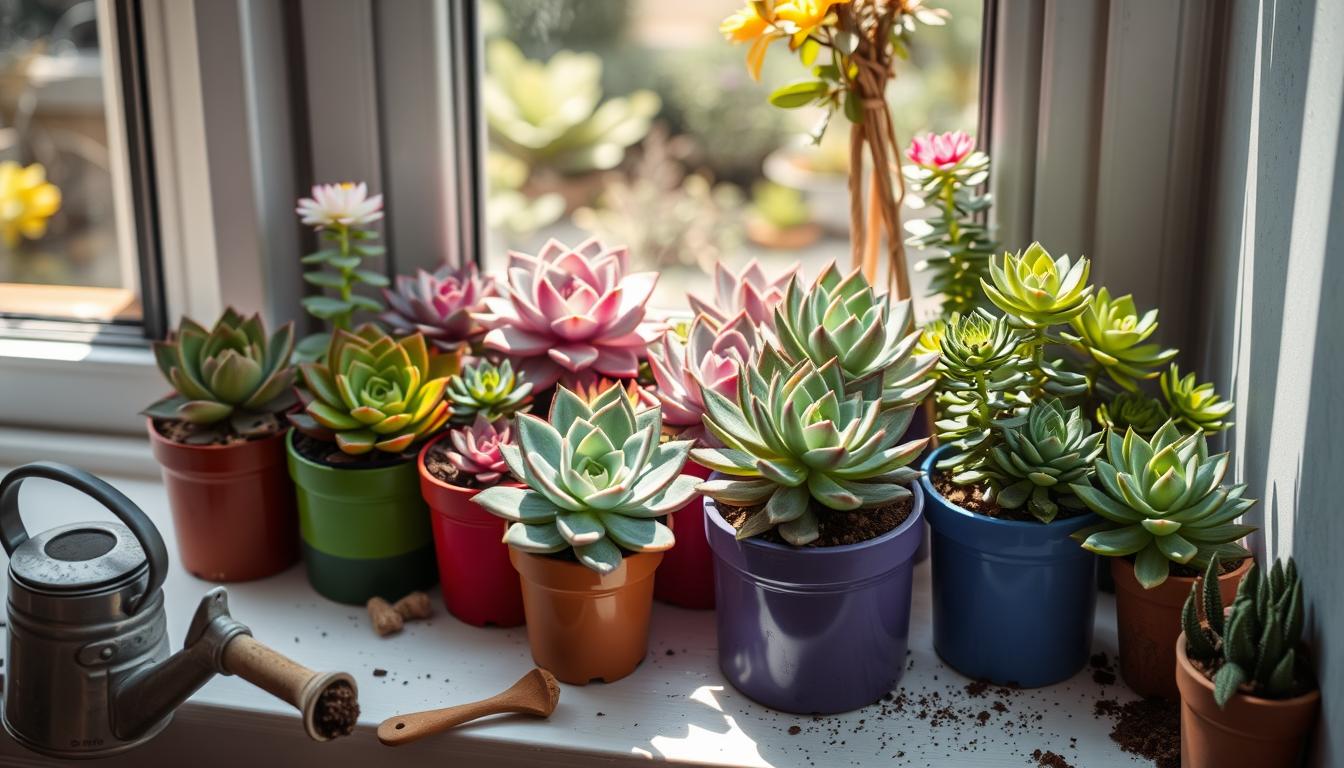
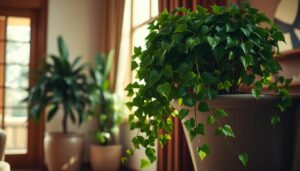
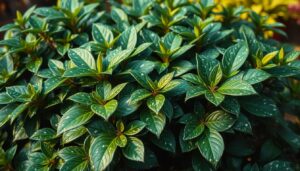

Pingback: 12 Stunning Indoor Succulents and Cacti for Your Home - Trusted House Plant Guide
Pingback: The Ultimate Guide to Houseplants: 100 Best Indoor Plants for Every Home - Trusted House Plant Guide